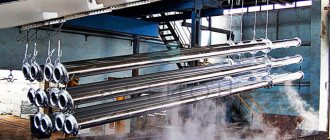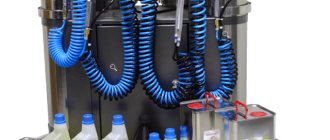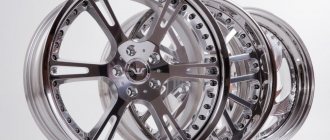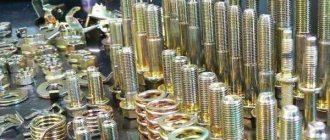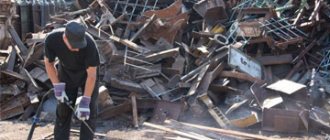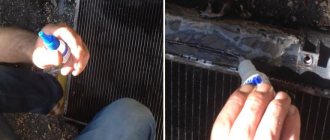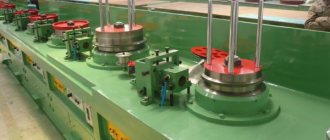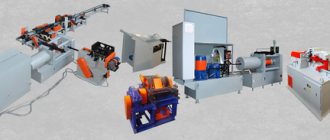To give metal surfaces a shine and improve their appearance, they are chrome-plated. This technology is most popular in the automotive industry. It is necessary not only to improve the appearance, but also to increase the strength of the workpiece. Among the most effective processing technologies, experts highlight galvanic chrome plating.
Galvanic chrome plating
The essence of the process
Chrome plating is a technological process of metalizing products with chromium. Thanks to it, the technical characteristics of the material are improved and the surface layers are strengthened.
The main advantages of the procedure:
- The base is restored and becomes stronger. The wear resistance indicator increases.
- Cracks not exceeding 1 mm in thickness are closed.
- Dirt and dust stick to the chrome surface worse.
- The decorative qualities of processed parts are improved.
The product is immersed in a chromic acid bath through which voltage is passed. The workpiece being processed acts as a cathode. Passive anodes are the walls of the container and additional plates, which are made from an alloy of antimony and tin.
Many novice car enthusiasts compare chrome plating with nickel plating, try to find the differences, and get confused about the advantages and disadvantages. Nickel-based plating is only superior in appearance. Its strength and wear resistance indicators are much worse.
Chrome disk (Photo: Instagram / funchrome)
General information
The thickness of the coating layer is usually small - from 0.2 to 0.8 millimeters (although there are products with a thicker layer). Any metals and their alloys (iron, cast iron, steel, aluminum, copper and others), as well as dielectrics (plastic, stone, wood, porcelain and others) can be chrome-plated.
You can coat dishes, jewelry, car or motorcycle parts, and furniture with chrome. In addition, chrome plating of parts and plastic performs the following important functions:
- Thermal and mechanical protection. Chrome has a dense structure and a very high melting point. Therefore, when heated, its chemical and physical structure does not change. During a mechanical shock, the substance also retains its structure, so chrome-plated parts have higher mechanical resistance.
- Anti-corrosion protection. From a chemical point of view, chromium is an inert substance. Under normal conditions, it does not come into contact with water and atmospheric air. Therefore, products with chrome coating do not corrode for a long time. Chromium also reacts reluctantly with acids, alkalis and salts.
- Restoring the strength of a spare part. In case of long-term use, small cracks and depressions appear in spare parts, which negatively affects their strength and reliability. Applying chrome plating can seal these cracks and dents, improving their practical use.
- Protects against dirt and increases reflectivity. The chrome coating reliably protects the part from dirt, dust and organic debris. People cover the spare parts of their vehicles so that their vehicles are better visible in the dark (usually discs, individual parts or the entire body are covered).
Classification
Chromium plating can be done in several ways:
- Galvanic. There are two types - diffuse, electrolytic. The first option involves applying chrome using a galvanic brush. The electrolytic type involves the use of a chromic anhydride solution into which the workpiece is immersed.
- Vacuum. The workpieces are placed in a vacuum chamber into which chromium vapor is supplied, which deposits on the metal surfaces, creating a protective layer.
- Chemical. The technology does not require the use of electric current. The mixture for treatment is prepared from sodium citrate, phosphorus, sodium hydroxide, and glacial acetic acid.
- Catalytic method. It can be classified as a chemical treatment. A working composition that does not contain acids is applied to the surface of the parts. It consists of silver in an alkaline ammonia solution. Additionally, a reducing agent is used - hydrazine or formalin.
- Thermochrome plating. The products are heated and coated with a working mixture - chromium powder or ferrochrome.
Chrome plating technology
Today there are 3 options:
- Galvanic method (in an electrolyte environment) - under the influence of current (when the required voltage is applied), Cr atoms are uniformly deposited on a conducting surface; Thus, they form a new layer, which is resistant to both mechanical damage and various aggressive environments.
- The chemical method boils down to the reduction reaction of Cr, which occurs (thanks to reagents) in a saline solution. Phosphorus will help eliminate the gray tint, a mixture based on copper, water and sulfuric acid will reliably cover those areas that do not need to be treated. Just apply it to areas that don't need to be coated. The use of personal protective equipment is mandatory.
- Decorative - the peculiarity here is that the layer is extremely thin; a special brush is used to apply it, and it is needed primarily for beauty, although it also provides some protection against corrosion. If something precious is chosen as an additive, the method is also called gilding or silver plating.
These are the main types of chrome plating, the most convenient, in demand, and often used in practice. Which one should you give preference to? This depends on many factors, but most often on what result needs to be achieved (what thickness to achieve), and how uniform the newly formed layer should be. Labor productivity is also important: the larger and larger the workpiece, the faster the method should be.
And most importantly: in Russia it is permissible to use the galvanic method only in industrial conditions, and then after obtaining a number of necessary licenses and permits, otherwise punishment will follow, even criminal.
Necessary equipment
Tools and equipment:
- DC source with adjustable output voltage. It is permissible to process small parts when using a charger for mobile phones.
- Galvanic bath. Must be made of heat-resistant plastic or glass. The main condition is resistance to high temperatures.
- Thermometer - necessary to control the temperature during the work process.
- A heating element. The best option is a ceramic heating element. The heater must withstand prolonged exposure to acids.
For processing, it is necessary to install at least two galvanic baths so as not to constantly change the reagents in one container.
Galvanic bath (Photo: Instagram / galvaprom)
Why is chrome plating needed?
Correct implementation of one of the selected technologies allows you to:
- Protect metal parts from destruction under the influence of sudden temperature changes, as well as from the harmful effects of rust.
- Restore the original geometry, which will make it possible to significantly extend the life of the product (if the wear depth does not exceed 1 mm).
- Improve reflective characteristics, which is important in the production of lighting fixtures, as it helps increase the visibility of signs and/or housing elements.
- Increase wear resistance by reducing the friction force during physical contact or thermal expansion; As a result, dangerous or clearly negative external influences do not have the same effect on the base material of the workpiece.
How to properly prepare the product for the procedure?
The quality of galvanic chrome plating depends on the preparation of the working surfaces. Stages:
- Cleaning from dirt, plaque, rust. For this, sandpaper and angle grinders are used.
- Degreasing surfaces with calcined water. To make the product, you need to mix 1000 ml of plain water with 50 ml of calcined water. Add 5 g of silicate glue and 0.15 kg of sodium hydroxide to the finished liquid. Mix thoroughly and heat the mixture.
The parts are immersed in degreasing liquid for 20 minutes.
Carrying out
Chrome plating at home must be carried out in compliance with a number of rules and safety precautions. Initially, it is necessary to prepare the equipment, make a working mixture - electrolyte. Manufacturing instructions:
- Buy a large container of distilled water. Pour the required amount of liquid into a container for heating. Preheat to 60°C.
- Add 250 g of chromic anhydride (per 1 liter of water). To stir thoroughly.
- Pour the liquid into the galvanic bath.
- Add 2.5 grams of sulfuric acid.
To equalize the density of the electrolyte, it is necessary to pass the rated current through it and keep the liquid in a dark room for 24 hours.
For galvanic chrome plating, 3 elements are required:
- Anode - this element is the workpiece being processed. The anode should not be allowed to touch the cathode.
- Cathode - made of tin with lead or pure lead. It is a metal plate whose area should exceed the anode.
- Electrolyte is the working composition, without which it is impossible to carry out chrome plating.
Chrome plating process:
- Warm up the electrolyte to 52°C.
- Place the workpiece in a galvanic bath.
- Apply operating voltage. The part must be processed for up to 1 hour. The more complex the shape, the longer the processing takes.
After the work process, the part is dried for 3 hours. You must not touch it with your hands.
Galvanic chrome plating procedure (Photo: Instagram / galvaprom)
Possible defects
When examining all planes of the metal after galvanic chromium plating, specific defects can be detected, which are most often associated with the composition of the electrolyte and the current density, but may also have other reasons.
If chromium does not deposit on the metal, this may be due to insufficient current density, excess sulfuric acid, elevated solution temperature, or oxidation of the anode.
If the chrome coating peels off from the metal, the reason for this may be poor cleaning of its surface and fluctuations in current parameters during the chrome plating process.
If the current density is exceeded, build-up may form on the protruding parts of the part, and the surface of the chrome-plated metal becomes dull and uneven. If the current density is too low, the coating becomes hard and has a “milky” appearance.
When galvanic chrome plating, the spatial position of the part is also important. It must ensure the free escape of hydrogen formed on the surface of the metal, since the accumulation of this gas leads to the formation of irregularities and cavities.
Safety precautions
In order not to harm your body, you should follow safety precautions:
- Before chrome plating, you need to establish ventilation and remove flammable mixtures from the work area.
- When preparing electrolyte and the work process, use protective gloves, goggles, and a respirator.
- Buy special bags for chemical waste in which you need to pack the remaining waste after processing.
- The room must be cleared of any organic matter. Otherwise, the items will be damaged.
Doctors recommend lubricating the inside of the nose with lanolin and Vaseline. The components are mixed in a 1:2 ratio. This will help protect the body from exposure to harmful fumes.
Galvanic chrome plating is used in various industries. With its help, the appearance of products is restored and their technical characteristics are improved. The treatment can be done at home, but it is important to mix the chemical components correctly.
